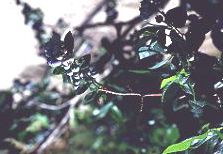
Sharpnosed leafhopper, Scaphytopius magdalensis Provancher
Biology: Causes little direct injury but is the only known
vector of the MLO causing blueberry stunt disease in highbush
blueberries (Marucci 1966, Milholland & Meyer 1984). Infestations
follow phenologically the population peaks of S. magdalensis
(Tozzi et al. 1993). Common throughout East (Marucci 1966). In
southeast 3 generations; north of Virginia 2 generations (Marucci 1966,
Meyer 1986). Overwinter as eggs in leaf tissue. In North Carolina,
hatch mid-March (about time blueberry buds begin to open). Nymphs ivory
color, dark wingpads make hourglass pattern (See NCSU photos of
young and mature
nymphs). Adults mostly brown with white markings on body and wings (NCSU photo).
Both adults and nymphs have a pointed head (anvil-shaped). Adults
disperse out of woods in spring, back to woods in fall (important in
MLO spread?). Milholland & Meyer 1984) list the three N. Carolina
population peaks as late May, mid-June and early October. Highest
populations in abandoned blueberry fields and wooded habitats where
huckleberry (Gaylussacia spp.) and blueberry (Vaccinium
spp.) are common in ground cover.
Chemical control: Petal fall spray hits first generation. In
the North, this spray has been adequate, but in South, additional
sprays needed to control damage by 2nd and 3rd generations, e.g. 2
weeks after harvest, 6 weeks after harvest, 3 months after harvest
(first or second week of October) (Meyer 1986). Meyer (1986) stated
that the petal fall spray is the most important for blueberry,
controlling plum curculio, cranberry and cherry fruitworms, and the
first generation of sharpnosed leafhoppers.
Monitoring: Use yellow sticky traps as for blueberry maggot (
NCSU photo). Place traps in low vegetation in woods, spraying
when catches begin to increase each generation. Sweep netting gives
variable results (Milholland & Meyer 1984).
Cultural control: Destroy infected bushes to avoid spread
(Meyer 1986).
Host plant resistance: Most cultivars are susceptible, but some
more so than others (Meyer 1986).
See the factsheet from NCSU
Additional reaeding:
- Etzel, R. W. and J. R. Meyer. 1986. Resistance
in blueberries to feeding and oviposition by the sharpnosed leafhopper,
Scaphytopius magdalensis Provancher. J. Econ. Entomol. 79:
1513-1515.
- Meyer, J. R. and J. R. Ballington. 1990.
Resistance of Vaccinium spp. to the leafhopper Scaphytopius
magdalensis (Homoptera: Cicadellidae). Ann. Entomol. Soc. Am. 83:
515-520.
- Tozzi, D. C. M., D. C. Ramsdell, O. Taboada,
I. M. Lee and R. E. Davis. 1993. Epidemiological studies on the stunt
disease of highbush blueberry. Ann. Appl. Biol. 123: 579-599.
Back to Small
fruit
page
Back to Mid-Atlantic
Regional Fruit Loop
Maintained by:
Douglas G.
Pfeiffer
Department of Entomology
Virginia Tech
Blacksburg
